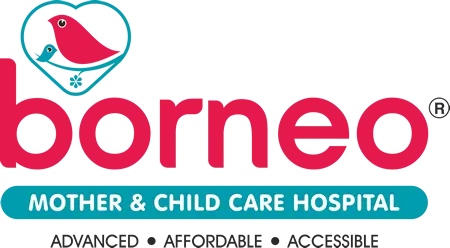As you approach the final months of pregnancy, thoughts naturally turn towards labour and delivery. Many expectant parents today, here in India and globally, are interested in exploring a “natural childbirth” – an experience focused on physiological processes with minimal medical intervention. If this is a path you are considering, thinking about your preferences and communicating them effectively becomes an important part of your preparation. This is where creating a birth plan can be a valuable exercise.
IMy name is Dr. Vrushali Pillai, and as a Senior Consultant Obstetrician & Gynaecologist at Borneo Hospital, Thane, part of the Borneo group serving families across Thane, Nashik, Chhatrapati Sambhaji Nagar, and Raipur, maternal safety is our absolute priority. We believe knowledge empowers families.
This article will guide you through the process of creating a Birth Plan for Natural Delivery. We’ll look at its purpose, what to include, and how to use it as a positive communication tool with your healthcare team. However, please understand this crucial point from the outset: A birth plan outlines your preferences; it is NOT a rigid script or a contract. Labour can be unpredictable, and medical situations may arise where deviating from the plan is necessary for safety. This guidance is intended for women who have already discussed their desire for a natural birth with their obstetrician and have been deemed medically suitable candidates for this approach. Flexibility and trust in your medical team are paramount.
What is a Birth Plan?
Simply put, a birth plan is a written document where you outline your hopes and preferences for labour, childbirth, and the immediate time after your baby is born.
Its primary purpose is communication. It serves as a clear and concise way to share your wishes with your doctor, midwife, nurses, and support people. It helps ensure everyone involved in your care understands what is important to you.
It is not a guarantee that everything will happen exactly as written. Childbirth involves many variables. Think of it as a map showing your preferred route, but be prepared for potential detours if the road conditions (your or your baby’s health) require them.

Why Create a Birth Plan for a Natural Delivery?
Taking the time to create a Birth Plan for a Natural Delivery offers several benefits:
- Clarifies Your Thoughts: The process encourages you to research different aspects of labour and birth, reflect on what matters most to you, and articulate your preferences regarding coping strategies, environment, and interventions.
- Facilitates Doctor Discussion: It provides a structured basis for important conversations with your obstetrician at Borneo Hospital. Discussing your plan helps align expectations and understand hospital policies and medical feasibility.
- Empowers You: Being informed and having expressed your wishes can help you feel more prepared, confident, and actively involved in your birthing experience.
- Guides Your Support Person: It gives your partner, family member, or doula a clear reference point to understand how best to support you emotionally and physically, and to help communicate your preferences respectfully if needed.
- Mental Preparation: Thinking through various possibilities and preferences helps you mentally prepare for the journey of labour and birth.
Key Components of a Birth Plan for Natural Delivery
Here’s a breakdown of sections you might want to include in your plan, with examples relevant to aiming for a low-intervention birth. Remember to frame these as preferences.
- Basic Information:
- Your name, age.
- Partner/support person’s name(s).
- Your doctor’s name (at Borneo Hospital).
- Estimated due date.
- Any key medical information (e.g., allergies, GBS status, relevant conditions).
- Labour Environment Preferences:
- Atmosphere: e.g., “I prefer dim lighting,” “I would like to play my own calming music,” “I prefer minimal interruptions.”
- Support People: “I would like my partner and my mother present.”
- Movement: “I hope to remain mobile and walk around during labour as much as possible.”
- Photography/Videography: Clarify your wishes regarding photos or recording.
- Labour Coping & Pain Management Preferences:
- Focus on Natural Methods: “My primary goal is to use non-pharmacological methods for pain management.” List specific techniques you plan to use: “I intend to use deep breathing, movement, massage, and potentially hydrotherapy (if available/safe).”
- Stance on Medical Pain Relief: Be clear but flexible. e.g., “I would prefer to avoid an epidural initially but wish to keep my options open and discuss it if I feel I need it,” or “If medical pain relief is needed, I would prefer to try Entonox (gas and air) first.” Discussing options beforehand with your doctor is sensible.
- Labour Monitoring Preferences:
- Foetal Monitoring: “I prefer intermittent foetal monitoring (Doppler checks/short monitor strips) if medically appropriate, to allow freedom of movement.” Add: “I understand continuous monitoring may become necessary if concerns arise.”
- Vaginal Examinations: “I prefer vaginal exams to be performed only when necessary to assess progress, with my consent.”
- Interventions During Labour:
- Induction/Augmentation: “I prefer labour to start and progress spontaneously and wish to avoid induction or augmentation (speeding up labour) unless medically indicated.”
- Artificial Rupture of Membranes (AROM): “I prefer my waters to break naturally, unless there is a clear medical reason for AROM.”
- Episiotomy: “I prefer to avoid a routine episiotomy and would rather tear naturally if needed. I understand an episiotomy may be necessary in certain situations.”
- Delivery Preferences:
- Pushing Stage: “I would like to try different pushing positions (e.g., upright, side-lying) and prefer guidance on pushing rather than directed pushing, if possible.”
- Immediate Post-Birth: “I wish for immediate and uninterrupted skin-to-skin contact with my baby for at least the first hour, provided the baby is stable.”
- Cord Clamping: “I prefer delayed cord clamping (waiting 1-3 minutes or until pulsation stops) before the cord is cut, if baby’s condition permits.” Discuss this policy with your doctor.
- Postpartum Care for Baby (Immediately After Birth):
- Initial Procedures: Discuss standard procedures like Vitamin K injection and eye ointment with your paediatrician/obstetrician beforehand and note your informed preference. e.g., “We consent to Vitamin K but prefer to delay eye ointment,” or “We consent to standard procedures.”
- Feeding Intentions: “I intend to breastfeed exclusively and would appreciate support with initiating breastfeeding as soon as possible.” “Please do not give my baby formula, sugar water, or pacifiers unless medically necessary and discussed with me first.” Borneo Hospital offer excellent lactation support.
- Baby’s Location: “I prefer my baby to room-in with me continuously.”
- Postpartum Care for Mother:
- Note any preferences regarding recovery, pain relief options after birth, and support needs.
- Contingency & Flexibility Statement (Very Important!):
- Include a sentence like: “We have written these preferences based on our hopes for a natural birth, but understand that labour and birth can be unpredictable. Our main priority is the safety and health of both mother and baby. We trust the professional judgment of our medical team at Borneo Hospital and are open to discussing changes to this plan if medically necessary.” This shows you are informed, prepared, but flexible.
Tips for Writing Your Birth Plan
- Keep it Concise & Clear: Aim for one page. Use bullet points or short sentences. Make it easy for busy staff to read quickly.
- Use Positive Language: Frame things as what you hope for or plan to do rather than what you don’t want.
- Be Realistic: Base your preferences on discussions with your doctor and knowledge of Borneo Hospital’s facilities and standard practices.
- Prioritise: If you have many preferences, perhaps highlight the 2-3 that mean the most to you.
- Make Copies: Keep copies for yourself, your partner/support person, give one to your doctor for your file, and bring copies to the hospital.
Discussing Your Birth Plan with Your Doctor & Hospital Team
Creating the plan is just the first step; discussing it is crucial for making it effective.
- Schedule Time: Don’t try to rush this conversation during a routine check-up. Ask for a specific time to discuss your birth preferences with your obstetrician at Borneo Hospital, ideally around 34-36 weeks.
- Collaborative Approach: View this as a dialogue. Present your preferences, listen to your doctor’s feedback regarding safety and feasibility, and be open to their expert advice. This discussion is useful towards setting expectations.
- Understand Hospital Realities: Ask about Borneo Hospital’s standard procedures regarding monitoring, movement, support people, pain relief options, etc. Understanding the typical approach helps align your plan realistically.
- Build Trust: This conversation is an excellent opportunity to build rapport and trust with your care team, ensuring you feel heard and supported.

The Role of Your Support Person
Your birth plan is a key tool for your partner, doula, or other support person.
- Their Guide: They should read it carefully and understand your wishes.
- Your Advocate: It empowers them to remind staff of your preferences respectfully, especially if you are focused inward during intense labour.
- Shared Understanding: Ensures everyone supporting you is on the same page.
Remember Flexibility: The Most Important Part
I cannot emphasise this enough: a Birth Plan for a Natural Delivery must come with an open mind.
- It’s a Map, Not a Mandate: Labour can take unexpected turns. Medical situations may arise that require interventions you didn’t initially want, but which become necessary for your or your baby’s safety.
- Trust Your Team: If your experienced medical team at Borneo Hospital recommends a change of plan due to arising complications, trust their judgment. Their priority is a safe outcome.
- Positive Experience Redefined: Try to define a positive birth experience not by whether every point on your plan was followed, but by feeling respected, supported, informed, and ultimately, achieving the main primary goal: a healthy mum and a healthy baby.
Creating a Birth Plan for a Natural Delivery is a worthwhile process for expectant parents who are suitable candidates for this approach. It encourages research, clarifies preferences, facilitates vital communication with your healthcare team, and helps you feel more prepared and empowered for the journey ahead. It serves as an excellent starting point for important discussions with your obstetrician.
Remember to approach it as a guide, infused with flexibility and trust in your medical team. At Borneo Hospital, we are committed to supporting your informed choices within a framework of absolute safety. We partner with you to achieve the best possible birth experience, celebrating the safe arrival of your little one, however that unfolds.



